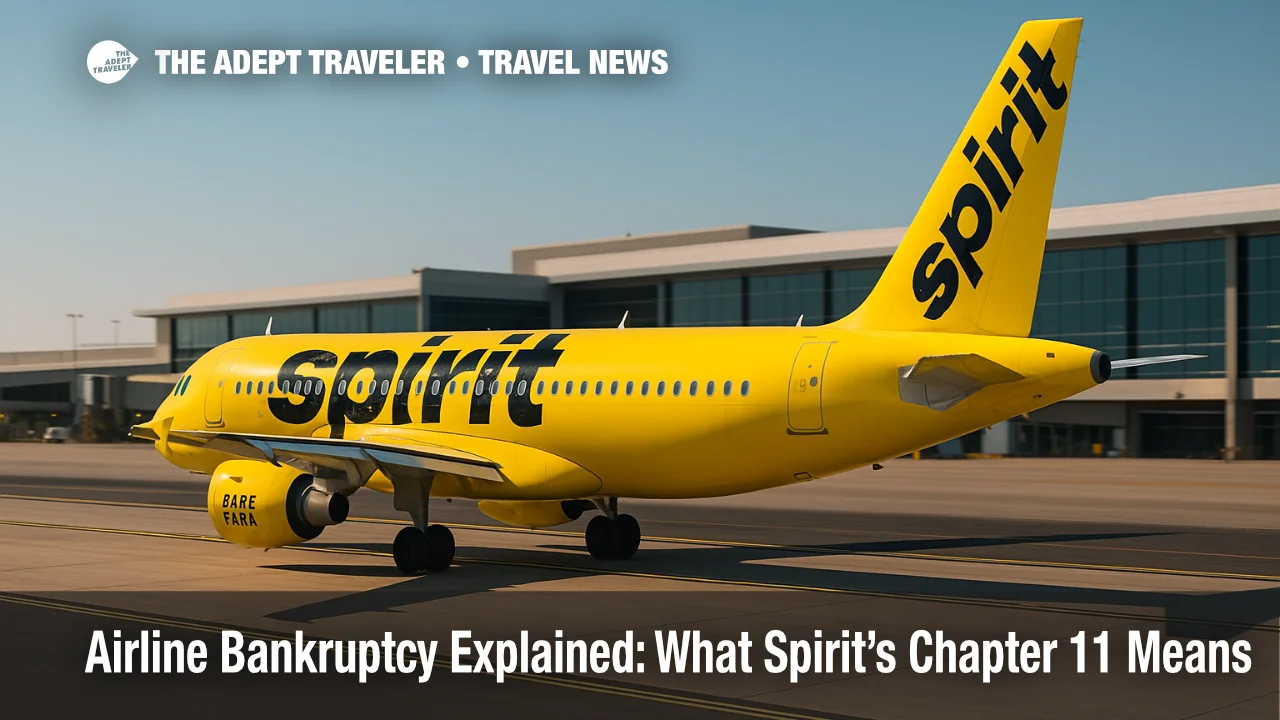Airline bankruptcy explained: what Spirit's Chapter 11 means

When an airline enters Chapter 11, it keeps flying while a judge oversees its finances and contracts. Tickets remain valid, loyalty accounts stay active, and the schedule mostly holds, though cuts and reshuffling are common. Spirit Airlines is the current real-world example: it has court-supervised financing, is trimming weaker routes, and is negotiating aircraft and airport leases. For travelers, the near term is about operational adjustments, not a sudden shutdown. The end state could be a leaner Spirit, a sale to a buyer, or, if financing fails, an orderly wind-down.
Key points
- Why it matters: Chapter 11 lets airlines keep operating while fixing debt, leases, and fleet plans.
- Travel impact: Flights continue, but expect schedule cuts, refunds, and rebooking options on some routes.
- What's next: Court rulings on financing and lease rejections determine how much network Spirit can keep.
- Loyalty and vouchers remain usable, though policies can shift with schedule changes.
- Endgames include stand-alone emergence, asset sale, merger, or liquidation if funding falls short.
Snapshot
Chapter 11 is a restructuring tool, not a stop-flying order. The airline proposes a plan, secures debtor-in-possession financing, and seeks court approval to renegotiate burdensome contracts. For Spirit, that includes new financing of up to $475 million pending an October 10 hearing, reworking aircraft and airport leases, and cutting underperforming routes. First-day court orders typically authorize payroll, vendor payments tied to safety, and customer refunds for canceled flights. Travelers should expect normal check-in and boarding, but also see targeted schedule reductions, fewer frequency options, and rolling timetable adjustments. Loyalty programs generally continue to accrue and redeem during the case, with any changes disclosed through filings and customer notices.
Background
U.S. airline bankruptcies are common in downturns and fleet transitions. The system is designed to protect safety and continuity while creditors negotiate. Spirit's filing, on August 29, 2025, follows months of cash pressure, prior court activity earlier in 2025, and a renewed push to resize the network and fleet. Since filing, Spirit has sought approval for DIP funding, moved to reject certain aircraft and airport leases, and announced route and staffing changes to stabilize cash burn. These steps mirror prior airline restructurings, where capacity is cut to match demand, aircraft are returned early, and noncore stations close. The court will weigh financing terms, creditor recoveries, and the feasibility of Spirit's go-forward plan before confirming any emergence.
Latest developments
Airline bankruptcy in practice: how Spirit's Chapter 11 affects flyers
Spirit has negotiated up to $475 million in DIP financing from bondholders to support operations, with $200 million expected to be available once approved. In parallel, Spirit is rejecting leases on over two dozen aircraft and some airport and ground-handling agreements, reducing fixed costs and allowing a tighter schedule. The carrier has announced about 40 route suspensions in upcoming schedules and plans to furlough approximately 1,800 flight attendants effective December 1, reflecting a smaller near-term operation. For travelers, this likely means thinner frequencies on leisure routes and some station exits, but continued service in core markets. If a flight is canceled, standard refunds apply; rebooking options will hinge on remaining Spirit service since the airline has limited interline coverage.
Related coverage on Adept Traveler: Spirit Airlines wins court approval to keep operating, Spirit cuts routes in 11 cities amid bankruptcy, Spirit secures restructuring funding.
Analysis
What should travelers practically expect during an airline bankruptcy? First, the airline continues to fly and honor tickets while the court process advances. The biggest traveler-visible changes are schedule trims, seasonal pullbacks becoming permanent, and station exits where costs outweigh revenue. Expect rolling adjustments 30 to 90 days out, with email notifications and options to refund or rebook inside Spirit's network. Credit-card protections can provide added refund coverage when flights are canceled; third-party insurance may cover trip disruption depending on policy terms. Loyalty points typically remain valid; however, redemption availability can tighten as capacity shrinks.
Medium term, successful financing and lease renegotiations can produce a smaller, more reliable airline with better aircraft utilization and fewer marginal routes. Spirit's plan work suggests a pivot toward its strongest leisure corridors and bases. Longer term, outcomes include: 1) stand-alone emergence with a right-sized fleet and route map; 2) a sale of assets or an overall merger through a court-supervised process if a buyer offers a superior recovery; or 3) liquidation only if financing collapses and no viable plan or purchaser emerges. Given the active DIP process and lease work to date, a restructuring or sale path appears more probable than a sudden shutdown, but the court and creditors ultimately decide.
Final thoughts
Airline bankruptcy is a structured reset, not an immediate grounding. Spirit's case shows how Chapter 11 can keep planes flying while management and creditors resize the business. Travelers should watch for schedule changes, protect bookings with flexible fares or cards, and plan alternatives on routes flagged for suspension. The likely outcomes range from a leaner stand-alone airline to a sale that reshapes network strategy; a shutdown is the backstop if financing fails. Understanding how Chapter 11 works helps you navigate disruptions today and anticipate the airline you might see tomorrow, which is the core of our guidance on airline bankruptcy.
Sources
- Spirit Airlines takes action to build a stronger foundation and future, Spirit Investor Relations
- Spirit Airlines receives court approval of first day motions, Spirit Investor Relations
- Spirit Airlines announces significant progress toward a successful restructuring, PR Newswire (company release)
- Spirit Aviation Holdings Chapter 11 case overview, Epiq
- Spirit Airlines gets up to $475 million financing amid bankruptcy process, Reuters
- Spirit Airlines to halt 40 routes, Reuters
- Spirit Airlines prepares to reject certain aircraft leases, Aviation Week
- Spirit Airlines to furlough one-third of its flight attendants, Reuters
